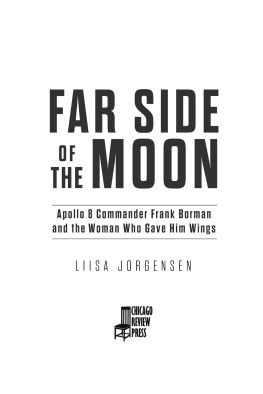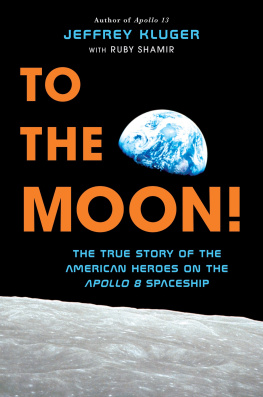Sommaire
Pagination de ldition papier
Guide
Copyright 2022 by Myth Merchant Films Inc.
All rights reserved
Published by Chicago Review Press Incorporated
814 North Franklin Street
Chicago, Illinois 60610
ISBN 978-1-64160-607-3
Library of Congress Control Number: 2021944683
Typesetting: Nord Compo
Printed in the United States of America
5 4 3 2 1
This digital document has been produced by Nord Compo.
This is a book about heroes. About some who are
known to us already but especially about
the ones who are unknown.
They are the ones who give us thrust.
We could not leave the ground without them.
This is for Colonel Frank Bormanthank you for
being a hero who actually lived up to the word.
Thank you for trusting me with your most precious memories.
And for Susan Borman, whose voice I have heard the whole
time I was writing this, thank you for the inspiration.
You are my Wonder Woman.
And to the rest of the astronauts wives and their children.
You are all warriors.
Authors Note
T his book is based on countless hours of in-person and telephone interviews with Frank Borman and many others mentioned in the acknowledgments, conducted over a two-year period from March 2019 to January 2021.
Those who knew Frank Borman in the past or have written about him will recall him as a serious, pragmatic, stubborn, tough-as-nails professional in everything he did. But when it comes to his beloved wife, Susan, the joy and pain associated with their love story brought this larger-than-life man to tears.
Frank never wavered in his recounting of the moments Im certain he would rather forget. On my first visit, I met with Frank in his modest home in Billings, Montana. There were no personal mementos that would tell you anything about his life in the US Air Force, NASA, or Eastern Airlines or any of the many trips he took around the world to represent his country. The only thing that hinted at his past life was hanging on a hook on the back of the garage door: the flight suit and baseball cap he uses when he goes flying at the age of ninety-two. Its still in his blood to get in the air.
The only photos displayed in his home are those of Susan and their family, and his most cherished memento is the last card Susan was able to write to him, which he keeps tucked away in the top drawer of his desk and showed me on one of my visits.
When I met Susan in the spring of 2019, she had already lost the ability to speak due to Alzheimers, but I feel I was able to hear her voice in some waythanks to the candid interviews I conducted with Frank and her friends and family.
During one of my visits Frank pulled out two watertight plastic containers with decades of cards and letters that Susan and he shared over their lifetime. Among Franks letters to Susan was one he wrote to her and the boys the night before Apollo 8 left for the Moon. It was something hed not seen since he penned it in the late hours of December 20, 1968.
Although the Bormans story unfolded in an analog world, the digital world has preserved much of their personal and professional lives. Courtesy of NASA, I was very fortunate to have access to a variety of films and printed materials, from the Gemini and Apollo flight plans and voice recordings to detailed mission transcripts. I have deep gratitude to the many writers and filmmakers that preceded me who captured the context and historical elements that are the backdrop to the Bormans story. Unless otherwise noted, all of Franks and Susans quotes and information about them are theirs.
Prologue
S ince humans first gazed into the heavens, the Moon has fascinated our collective imaginations.
When Apollo 8 commander Frank Borman first saw the far side of the Moon, it was like nothing ever seen on Earth. Nothing was that desolate. It was a harsh place with no colorjust shades of gray everywhere you looked. This was the only time during that historic voyage that all communication was cut off from NASA and everything that connected him to home.
We have those times in life. Times when there is a loss of signal and we cant see anything but the void. For the crew of Apollo 8, that period of disconnection from the world they left behind in December 1968 lasted about forty-seven minutes every time they made the revolution around the Moon and were cut off from everything and everyone that they loved.
All the technology that got them there couldnt reach them in that place.
For those of us who experience that disconnection in our own lives, the abyss can last for much longer. It might seem that the loss of signal is permanent. But it never is.
After we finally come around to the other side and see the light, we look back and realize how sometimes the desolation can be beautiful. We can see what it taught us, what we learned.
As we gaze ahead to the brilliant colors in front of usbeautiful Earthwe appreciate it even more for having lost it for a while.
This is not a story about an astronaut who accomplishes the impossible.
This is a story about love and how it becomes the gravity that brings us back into the light.
You Killed Your Father
S usan Borman was lying in bed on the night of December 28, 1972. She had just hosted a dinner party of some of the top executives of Eastern Airlines with her husband, former astronaut Colonel Frank Borman, who was now the senior vice president of Eastern after retiring from NASA barely two years earlier. She had made their apartment in Miami as welcoming as possible, knowing what her role was in the new career her husband had taken onto be the consummate hostess. She was used to adapting, after moving over nineteen times in their twenty-two-year marriage. The wife of an ambitious air force pilot turned astronaut, she was accustomed to almost everything that life could throw at a person.
But on this night, lying in the dark beside her sleeping husband, who had no idea what was really going on, she felt like she couldnt breathe again and knew that she was in for another sleepless night. She wanted another drink so badly. It was the only thing that helped.
Eastern Airlines Flight 401 was on its final approach into Miami International after midnight on what had just become December 29, 1972. The airplane left New York on time, and it had been a normal, uneventful flight right up until the pilot attempted to lower the landing gear. An indicator light in the cockpit that confirmed the landing gear was down and locked didnt come on, and the pilot and crew had to figure out if it was a burnt-out light bulb or something more serious.
The pilot decided to check the issue out himself. He put the plane in autopilot, left the cockpit, and was trying to get to the bottom of the problem with a maintenance technician. Unbeknownst to him and everyone else, the copilot accidently bumped the control yoke and kicked it out of autopilot. The plane was gradually descending, and because the crew was fixated on figuring out what was wrong with the landing gear, no one realized it until it was too late. Investigators would uncover later that a burnt-out indicator light was responsible for the chain of events to follow.
In approach control at Miami International Airport, a ground controller was watching his radar screen, and the dot that represented Flight 401 seemed fine until the letters CST appeared, which stood for coast or sea level. The controller started trying to contact the aircraft to see if the crew needed help. There was no reply.
Eastern 401, the worried controller radioed, Weve lost you on the radar.... What altitude are you at? Come in, 401.










